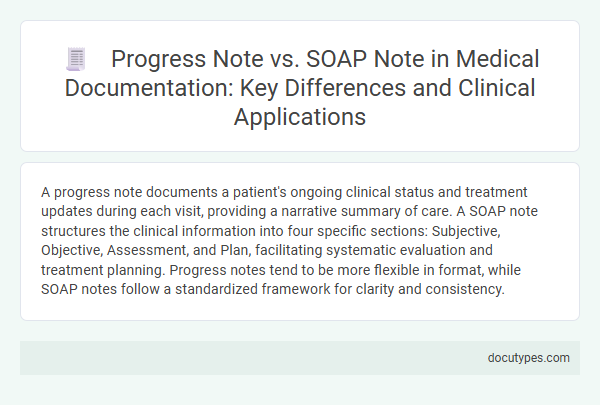A progress note documents a patient's ongoing clinical status and treatment updates during each visit, providing a narrative summary of care. A SOAP note structures the clinical information into four specific sections: Subjective, Objective, Assessment, and Plan, facilitating systematic evaluation and treatment planning. Progress notes tend to be more flexible in format, while SOAP notes follow a standardized framework for clarity and consistency.
Introduction to Medical Documentation
Medical documentation plays a crucial role in providing comprehensive patient care. Progress notes and SOAP notes are common methods used to record patient information systematically.
Progress notes offer a broad overview of a patient's clinical status over time. SOAP notes structure this information into specific sections: Subjective, Objective, Assessment, and Plan.
Overview of Progress Notes
Progress notes serve as comprehensive records of a patient's ongoing medical care, capturing detailed observations and treatments during each visit. These notes emphasize the continuity of care and the patient's evolving clinical status throughout the treatment process.
- Comprehensive Documentation - Progress notes include extensive clinical information beyond the structured format of SOAP notes.
- Ongoing Patient History - They track changes in the patient's condition and response to treatment over time.
- Flexible Format - Progress notes allow clinicians to record information in various formats tailored to your specific clinical practice needs.
Overview of SOAP Notes
SOAP notes are structured medical records used by healthcare providers to document patient encounters. The acronym SOAP stands for Subjective, Objective, Assessment, and Plan, outlining a systematic approach to patient care.
Subjective data includes the patient's reported symptoms and history, while Objective data consists of measurable clinical findings. The Assessment summarizes the diagnosis, and the Plan details treatment strategies and follow-up actions.
Structural Differences: Progress Note vs. SOAP Note
Progress notes and SOAP notes are essential tools in medical documentation, each with distinct structural characteristics. Understanding these differences can enhance the clarity and efficiency of your patient records.
- Progress Note Structure - Typically follows a narrative format, documenting ongoing patient care and observations over time without rigid sections.
- SOAP Note Structure - Organized into four clear sections: Subjective, Objective, Assessment, and Plan, providing a standardized approach to clinical documentation.
- Purpose and Usage - Progress notes offer a flexible summary of patient progress, while SOAP notes are designed for systematic clinical problem-solving and treatment planning.
The structural differences between progress notes and SOAP notes influence how medical information is recorded and interpreted in clinical practice.
Key Components Compared
Progress notes and SOAP notes serve distinct purposes in medical documentation. Understanding their key components highlights these differences clearly.
- Structure - Progress notes follow a flexible format that can vary by healthcare provider or setting.
- SOAP Note Format - SOAP notes strictly adhere to Subjective, Objective, Assessment, and Plan sections for organized clinical reasoning.
- Content Focus - Progress notes emphasize overall patient status updates, while SOAP notes concentrate on specific clinical problems and treatment decisions.
Clinical Scenarios for Progress Note Usage
Progress notes document a patient's clinical status and treatment over time, providing a comprehensive record of ongoing care. SOAP notes focus specifically on organizing clinical information into Subjective, Objective, Assessment, and Plan components for each encounter.
In clinical scenarios, progress notes track patient improvements, responses to therapy, and any changes in condition across multiple visits. They support continuity of care by informing all members of the healthcare team. Progress notes are essential in chronic disease management and complex case monitoring, where detailed and longitudinal documentation is required.
Clinical Scenarios for SOAP Note Usage
Progress notes provide a general record of a patient's clinical status and treatment over time, documenting observations, interventions, and patient responses. SOAP notes are a specific type of progress note structured into four components: Subjective, Objective, Assessment, and Plan, facilitating systematic clinical decision-making. In clinical scenarios, SOAP notes are particularly useful for complex cases requiring detailed problem-solving and multidisciplinary communication.
Advantages and Limitations of Each Format
How is a progress note different from a SOAP note in medical documentation? A progress note offers a general overview of a patient's clinical status and treatment updates. SOAP notes organize information into specific sections: Subjective, Objective, Assessment, and Plan, promoting clarity and detailed documentation.
What are the advantages of using a progress note? Progress notes provide a quick, flexible summary of patient encounters, making it easier to track ongoing treatment without rigid structure. This format suits diverse clinical settings and supports continuity of care by capturing broad information efficiently.
What limitations does a progress note have compared to a SOAP note? Progress notes may lack detailed organization, which can lead to inconsistencies in documentation and challenges in finding critical information quickly. The absence of a standardized format may affect communication across multidisciplinary teams.
What are the benefits of a SOAP note format in medical records? SOAP notes enhance clarity by separating subjective patient information from objective findings, assessments, and treatment plans. This structured approach improves diagnostic accuracy, treatment planning, and facilitates better legal documentation.
What drawbacks should you consider with SOAP notes? The detailed and structured nature of SOAP notes can be time-consuming and may require additional training for consistent use. In fast-paced environments, this format might slow documentation, potentially impacting workflow efficiency.
Best Practices in Medical Documentation
A progress note documents a patient's ongoing clinical status and treatment response, whereas a SOAP note organizes information into Subjective, Objective, Assessment, and Plan sections for clarity. Progress notes often emphasize narrative detail and continuity of care, while SOAP notes prioritize structured, concise data entry. Both formats are essential for accurate medical documentation, improving communication among healthcare providers and enhancing patient outcomes.
How Is a Progress Note Different From a SOAP Note? Infographic

